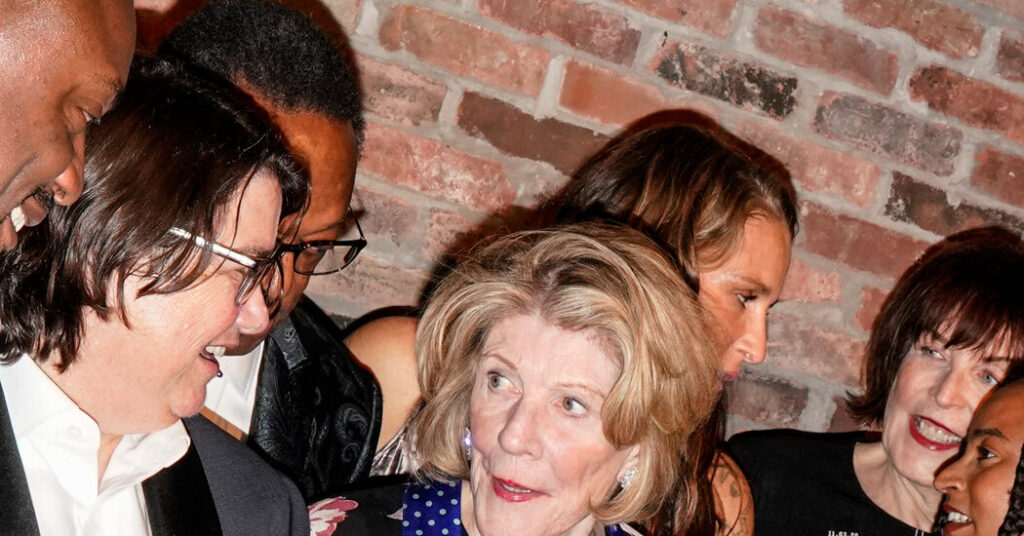When the economy tanked in 2008, just a year after the Whitney Museum of American Art announced plans for a new building in downtown Manhattan, the cosmetics executive Leonard A. Lauder swooped in with a $131 million donation, the largest in the museum’s history.
Lauder five years later bestowed his benevolence on the Metropolitan Museum of Art, giving it a Cubist trove valued at $1 billion, the most significant gift in its history.
“Most collectors give a big gift and then it’s over,” Lauder told The New York Times last year, “I never stop.’’
Like Lauder, Agnes Gund was a major supporter of institutions like the Museum of Modern Art and MoMA PS1 and did more than simply write checks. In the 1990s, when her fellow MoMA board members balked at adding living contemporary artists to the collection, Gund — known as Aggie — not only spoke up, but showed up with donations of works by the likes of Nick Cave, Julie Mehretu, Glenn Ligon and Kara Walker.
“Where it required moral leadership, Aggie was always there,” said Glenn D. Lowry, the museum’s former director, “despite a lot of pressure from her peers.”
For half a century, Lauder and Gund were among the leading lights of arts philanthropy in New York, but both died this year, leaving a gaping hole in the cultural firmament and highlighting the dearth of comparable titans coming up behind them.
“There are very few all-in-one philanthropists. Leonard and Aggie were those all-in-one philanthropists,” said Adam D. Weinberg, the former longtime director of the Whitney. “They could open doors, they could bring people together, they would give money, they would give art. It takes three different board members to contribute what they could.”
The arts in New York, and beyond, have been built on the shoulders of people who were not just wealthy, but also passionately committed to supporting the growth of cultural institutions. The Astors, Carnegies, Rockefellers, Fricks and Guggenheims made supporting the arts powerful and prestigious.
In some cases — Andrew Carnegie comes to mind — philanthropy was the flip side of a certain ruthlessness in the pursuit of business goals. And sometimes generous donors have defaulted on their donations or been tainted by scandal. But whether virtuous or simply ambitious, the breed of arts magnates seems to be dwindling at a time when cultural organizations most need champions.
Federal art funding has been cut. Many nonprofit arts groups continue to struggle to regain prepandemic audiences. And the data points to a precipitous decline in private donations.
One-third of American museums have lost government grants or contracts since President Trump took office, according to a survey released this month by the American Alliance of Museums, which represents 35,000 museums and museum professionals across the country. The losses have forced museums to defer construction projects, reduce or cancel programming and lay off employees.
Individual donations to arts institutions fell by more than 30 percent in just one year, according to a recent study by SMU DataArts, the National Center for Arts Research, at Southern Methodist University, which analyzed data from more than 6,500 arts nonprofits. Corporate support declined by 41 percent, government funding by 26 percent and foundation funding by 25 percent.
“When you look across the entire donor landscape, what you see is increased expenses, massively smaller audiences and fewer donors,” said Karen Brooks Hopkins, the former long-serving president of the Brooklyn Academy of Music. “When you put these three things together, you have a serious financial problem.”
Part of the decline in cultural giving is because of an overall sense of financial uncertainty under Trump’s tariffs, arts experts say, as well as the competing pull of social and political causes. Aggravating matters, tax law changes due to take effect in 2026 will affect arts donations by introducing a floor on itemized deductions, capping the deduction benefit for high-income donors.
“That will make it even less attractive for wealthy people to contribute to charities,” Hopkins said.
While Gund and Lauder distributed their largess among multiple institutions and maintained it over decades, arts experts say that today’s donors may step up for one particular gala, capital campaign, performance or exhibition.
“Where are the most important arts patrons — the ones we could count on to support so many things?” said Michael M. Kaiser, chairman of the DeVos Institute of Arts and Nonprofit Management at the University of Maryland, who used to head the John F. Kennedy Center for the Performing Arts in Washington. “We’re now in this time where we’re losing so many of these around the country.”
Donors in the league of a Gund or a Lauder are themselves often well past 70, without a clear crop of new blood in their wake.
Michael R. Bloomberg, the former New York mayor and the financier who gave $130 million gifts to the Perelman Performing Arts Center in Lower Manhattan and the Shed in Hudson Yards, is 83. David Geffen, the entertainment mogul who gave $150 million to the Los Angeles County Museum of Art’s new building and $100 million toward the New York Philharmonic’s refurbished home at Lincoln Center, is 82.
Stephen A. Schwarzman, the Wall Street financier who gave $150 million to Yale University for a cultural center and $100 million to the New York Public Library, is 78. And David M. Rubenstein, the former chairman of the Kennedy Center who contributed $120 million to that institution over the years, is 76.
Lauder’s brother, Ronald S. Lauder, who helped found the Neue Galerie, gave a large gift of arms and armor to the Met and has donated generously to MoMA as a trustee, is 81.
“If you look at the arc of New York City history over the last 100 years, there were seminal figures who played unique and transformational roles in defining art and culture,” said Darren Walker, the former president of the Ford Foundation. “They were people who defined the landscape of cultural life in the city through the institutions they built, the art they bought and donated and the kinds of artistic endeavors they supported — whether it was in museums or dance or theater or music.
“They weren’t just arts patrons, they were civic leaders,” he added, “and other wealthy philanthropists followed.”
The landscape is not devoid of generous art devotees. A younger generation includes Sarah Arison, 41, who last year became president of MoMA’s board of trustees; Anne-Cecilie Engell Speyer, 49, who recently became president of the Whitney; and Blair Effron, 63, who serves on the boards of both the Met Museum and Lincoln Center.
Agnes Hsu‐Tang is another younger philanthropist who has become an important supporter of the arts. She is 53, though her husband, Oscar L. Tang, is 87. Together they have given $125 million to the Met Museum’s new Modern and contemporary wing, $40 million to endow the Philharmonic’s chair for the maestro Gustavo Dudamel, and $20 million for the New York Historical to complete its new Wing for American Democracy.
Engell Speyer said that, given New York’s long tradition of cultural giving, philanthropic leaders will emerge over time. “It takes years,” she said. “You’re not born a legend.”
Mario J. Palumbo Jr., the chairman of the High Line, added that it was important for cultural organizations to move beyond the fund-raising model of “burrata salads at events” and think creatively about how to increase earned revenue and ease the burden on individual donors (the High Line is working on a new retail program).
“Aggie Gund and Leonard Lauder were giants and I don’t see giants behind them,” he said. “But I see deeply engaged people who care a lot about these organizations who are determined to grow the bases of support and that gives me hope.”
Gund’s legacy grew because of the breadth of her involvement (she was awarded the National Medal of Arts in 1997). She championed female artists and artists of color, co-founding the Center for Curatorial Leadership to train a diverse crop of curators; founded Studio in a School to give artists steady teaching work; and used $165 million from the sale of her prized Roy Lichtenstein to create Art for Justice to support organizations working in criminal justice reform.
Gund was known for traipsing around to artist studios, classrooms, galas and gallery openings — no matter how far-flung — even into her final days, as her physical capacities became more limited.
“In some ways, her collecting was secondary to her relationship to the artists themselves,” said the artist Glenn Ligon. “Lots of people collect work and are generous and serve on boards. She would show up for things.”
Arts experts say that kind of deep and reliable commitment is going to be hard to come by going forward.
“It’s a very scary time for the arts,” Kaiser said. “Many organizations have been losing some of their major patrons. And they’re not being replaced.”
Robin Pogrebin, who has been a reporter for The Times for 30 years, covers arts and culture.
The post After the Death of Two Titans, Where Are the Next Giant Art Patrons? appeared first on New York Times.




